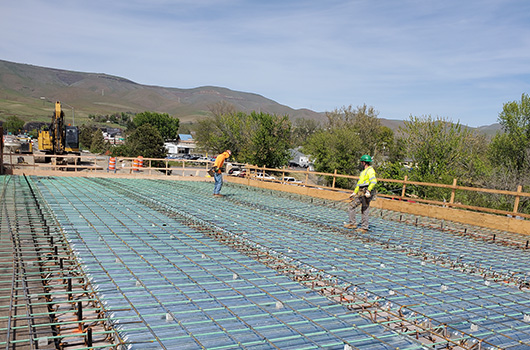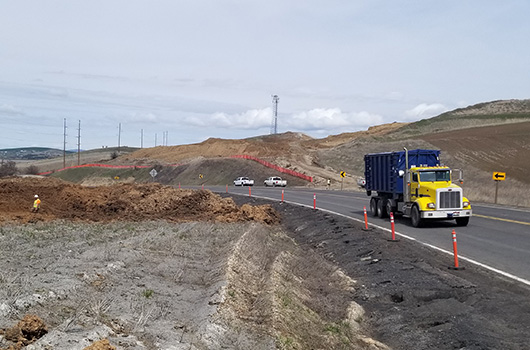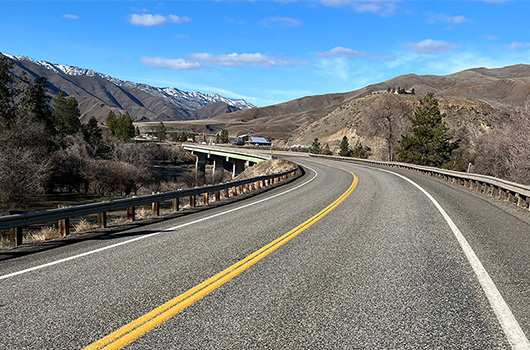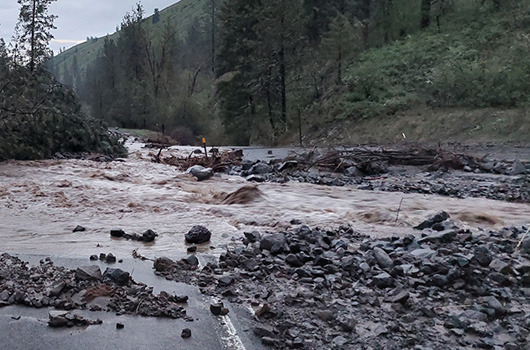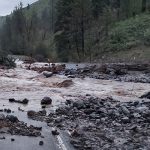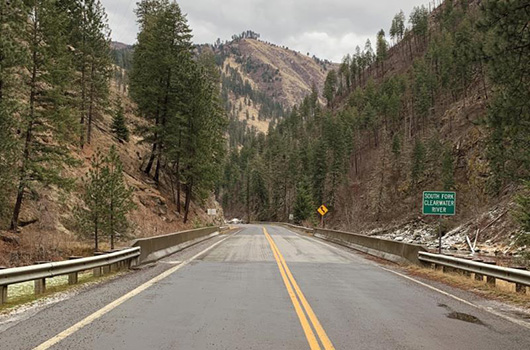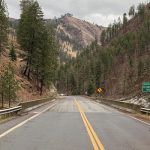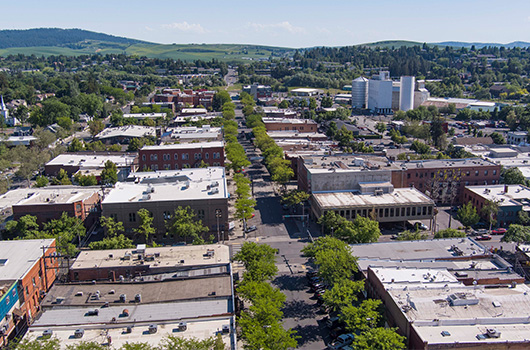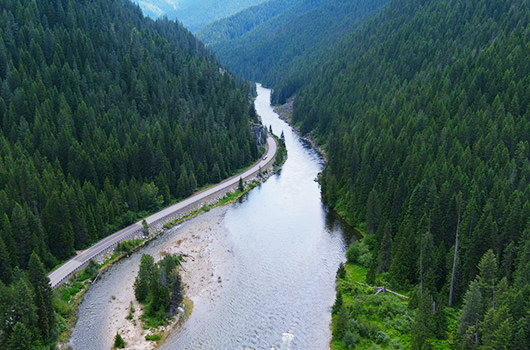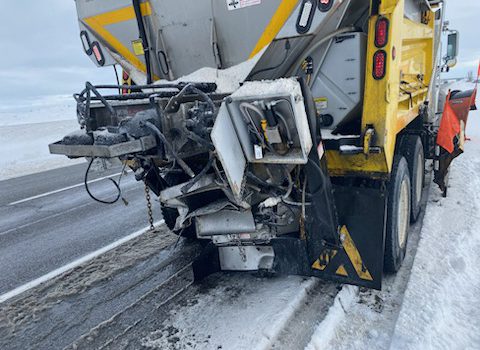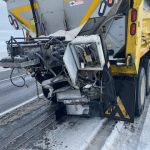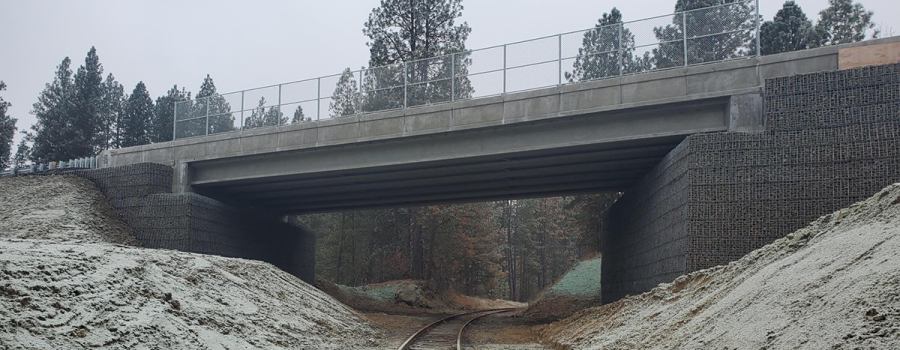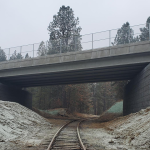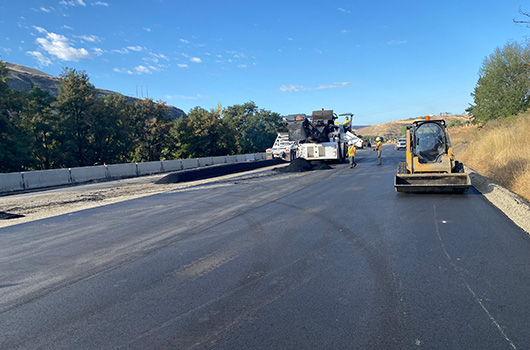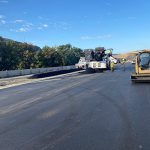Motorists can expect traffic on U.S. Highway 12 Clearwater Memorial Bridge to be reduced to one lane tonight at 7 p.m. while crews pour concrete for the new deck. Flaggers will allow traffic to take turns crossing the bridge until work is complete mid-morning tomorrow. Delays should be a maximum of 15 minutes.
Drivers should plan for similar delays next week when concrete will be poured for the opposing lane on the nights of May 15 and May 22. Each pour will take several hours to set, and the work is expected to go into the mid-morning hours.
Bridge construction will conclude by the end this year. The new bridge will enhance safety by providing wider lanes, wider shoulders for bicyclists and wider sidewalks for pedestrians. Live traffic impacts across the region can be found by visiting 511.idaho.gov, dialing 5-1-1 or downloading the app.
Motorists are asked to slow down in the work zone for a closed lane near Reisenauer Hill on U.S. Highway 95 south of Moscow as part of ongoing realignment and expansion.
Travelers can expect the southbound right lane to be closed through mid-May with speeds reduced to 35 mph in the two-mile work zone. Intermittent flagging operations, additional lane closures, and other changing conditions will impact traffic.
In early May Eid Road will be closed and restricted to local traffic only for approximately 10 weeks. Construction off this road is the site for two bridges on the realignment.
Once temporary lanes are built around the work area in mid-May, drivers will be able to travel at 45 mph. One lane will be open in each direction.
Expanding the highway to four lanes on a new alignment will not only add capacity and reduce travel times but also significantly improve safety. To learn more about the project please visit itdprojects.idaho.gov/pages/us95thorncreektomoscow.
Live traffic impacts across the region can be found by visiting 511.idaho.gov. Travelers can also dial 5-1-1 or download the app onto mobile devices.
Motorists can expect construction on U.S. Highway 95 this Monday as crews start resurfacing 13 miles between milepost 210 and Whitebird.
Work will restore the roadway and provide a smoother traveling surface to improve mobility through this vital corridor. Sections of guardrail will also be updated to current standards for enhanced safety.
Over the next few months, travelers can expect the following traffic shifts on US-95:
- Mid-April through mid-May: One-lane closed during the day.
- Mid-May through mid-July: One-lane closed during the day and night.
- Mid-July through mid-October: One-lane closed during the day.
Drivers should reduce speed and be on the lookout for flaggers and/or pilot cars in operation. Wait times are estimated to be around 15 minutes but should not exceed 30 minutes.
The cost for the project is $17.3 million.
Live traffic impacts across the region can be found by visiting 511.idaho.gov. Travelers can also dial 5-1-1 or download the app.
Two highways west of Kamiah were closed until further notice due to rockfall and flooding. State Highway 64 is closed from milepost 24 to milepost 30, and State Highway 162 is closed from milepost 14 to milepost 22.
SH-64 and SH-162 closed last night. Besides the significant debris, the road has received structural damage from the washout.
“Crews have been working hard since late last night to clear dozens of debris flows,” Operations Engineer Jared Hopkins said. “Please watch for our operators staffing the barricades and be prepared to turn around or find an alternate route.”
Travelers between Nez Perce and Kamiah are advised to use U.S. Highway 12 and U.S. Highway 95.
Updates on these closures will be posted to 511.idaho.gov. Travelers can also dial 5-1-1 or download the app.
Approximately 10 bridges across North Central Idaho are slated for repair and preservation work this spring, with work first beginning Monday at the bridge on State Highway 6 over the Palouse River near Harvard.
Delays for all of the bridge work this spring will be minimal, but drivers should use caution when crews are working on the bridge decks.
Surface treatments will extend the life and improve the riding surfaces of the bridge decks. Concrete waterproofing treatments will also be applied to various components of the bridges for enhanced preservation.
The bridges are in Latah, Nez Perce, Clearwater, and Idaho counties respectively:
- State Highway 14 over the South Fork of the Clearwater River
- State Highway 11 over Jim Ford Creek
- SH-11 over Orofino Creek
- SH-11 over Quartz Creek
- SH-6 over the Palouse River
- State Highway 8 over Paradise Creek
- U.S. Highway 95 over Palouse River
- US-95 over the South Fork of the Palouse River
- US-95 over Cow Creek
- US-95 over Paradise Creek
Construction will conclude by the end of June. Live traffic impacts across the region can be found by visiting 511.idaho.gov. Travelers can also dial 5-1-1 or download the app.
The Idaho Transportation Department will host a series of public meetings this month about two new planning environmental linkages studies on U.S. Highway 95 and State Highway 8. The purpose of these studies is to determine purposeful investments in the transportation network to improve safety and mobility and serve the communities and regional economic needs on US-95 between Snow Road and the Latah/Benewah County line, and on SH-8 between the Washington state line and Troy. Community members are invited to meet with the study team, review and comment on the draft Purpose and Need Statements, and provide suggestions for potential improvements.
The meetings will take place:
- Tuesday, April 9 from 4:30 – 7 p.m.
- Potlatch Jr.-Sr. High School, Multipurpose Room (130 6th St., Potlatch ID)
- Wednesday, April 10 from 4:30 – 7 p.m.
- Best Western Plus University Inn (1516 West Pullman Rd, Moscow ID)
- Thursday, April 11 from 4:30 – 7 p.m.
- Troy Elementary School, Gymnasium (103 Trojan Dr., Troy ID)
- Online, from April 9 – 23
“Community input is a fundamental part of this early process,” said ITD Project Engineer Janet Zarate. “This is just the first of many opportunities that will be available to the community to participate and provide feedback on these projects.”
ITD will use community input to help identify and develop potential improvements and alternatives for the study areas. ITD will host another series of public meetings to share those ideas in early 2025.
More information about the studies is available at itdprojects.idaho.gov/pages/sh8-us95-pel.
Starting next week travelers on U.S. Highway 12 east of Lowell should expect to encounter construction as crews resurface and widen nine miles of the highway to include shoulders.
Work will take place between the Lochsa Ranger Station and Holly Creek and will conclude in mid-October. This is the final phase of the project.
Tree removal will start as early as Monday in preparation for widening.
Throughout construction the highway may be reduced to one lane with possible delays up to 30 minutes. Watch carefully for flaggers or pilot cars. Additional instructions for pedestrians and bicyclists to navigate through the work zone will be shared in a separate announcement closer to the summer.
Click here to view a map of the project.
Live traffic impacts can be found by visiting 511.idaho.gov. You can also dial 5-1-1 or download the app. For information on this ITD project, check https://itdprojects.idaho.gov/pages/us12rangerstationtoholly.
Winter weather has brought snowy driving conditions to much of Idaho. Unfortunately, the rise in snowy road conditions has also led to a sharp rise in snowplow strikes. Nine Idaho Transportation Department (ITD) plows have been hit so far this winter season. Five strikes happened over the last seven days.
Two of the most recent strikes happened this Wednesday in the Magic Valley, one on I-84 north of Twin Falls, and one on I-84 west of Wendell. Both involved a semi truck rear-ending a plow. The vehicles will be out of service for up to two weeks while they undergo repairs.
“It’s a major impact on maintenance sheds when equipment is taken out of service. We are limited on snowplows,” Jerome Foreman Brian Davidson said. “It makes it more difficult to keep roads clear.”
Another recent strike happened on Tuesday in Nampa. The plow was heading eastbound on I-84 near Karcher Road. A pickup pulling a trailer merged onto the interstate and lost control. The trailer swung out and hit the ITD vehicle’s wing plow. There was no lasting damage to the snowplow.
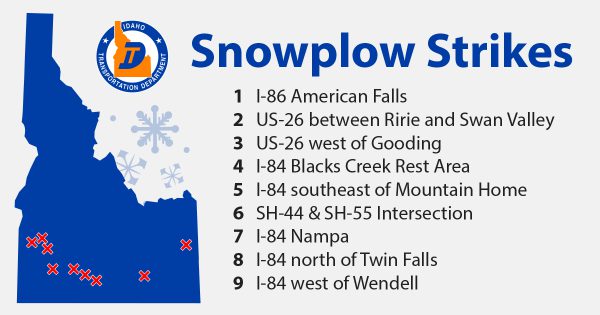
ITD wants to remind drivers how to be safe around snowplows.
- Do not pass a plow on the right. Plows have a 10-foot extendable wing plow on the right side that may be difficult to see in snowy conditions.
- Provide ample space for plows to work and steer clear of their blind spots. This also means increasing your following distance behind the plow.
- Practice patience and stay behind the plow for the safest road conditions.
- Plows often operate in pairs to clear multiple lanes; never position yourself between tandem plows.
- In case of a crash or if you need to stop on the side of the road, stay inside your vehicle for both your safety and that of our plow operators.
Last winter, there were 17 plow strikes, a number ITD does not want to repeat. Please be careful driving and mindful of our plows. Check 511.idaho.gov or the Idaho 511 App for road conditions before traveling. For more winter driving tips, visit itd.idaho.gov/travel.
*For real-time updates and photos of plow strikes, visit ITD’s Facebook or X pages.
Tomorrow crews will work on the bridge on U.S. Highway 95 over the Washington Idaho Railroad near Potlatch. The deck will be ground down for a smoother traveling surface and be completed by the end of the day.
One lane in each direction will be open to traffic, but motorists will not be able to pass. Flaggers will be in place to help drivers turn off and on to State Highway 6. Drivers can expect delays that are under 15 minutes.
Live traffic impacts can be found by visiting 511.idaho.gov. You can also dial 5-1-1 or download the app.
Fall construction is progressing at the Aht’Wy Interchange on U.S. Highway 95 near the Clearwater River Casino & Lodge RV Park, and motorists should expect a new traffic pattern starting Thursday, November 16.
Drivers will be able to travel on newly paved lanes, with eastbound traffic no longer crossed over to the westbound lanes. A concrete barrier will divide both lanes. Single lanes remain for each direction of travel and the speed limit is lowered for continual safety.
Changes will not affect either entrance to the plaza. At the west entrance, drivers are still unable to turn left from US-95 into the plaza or turn left from the plaza onto US-95.
To see a graphic for access to and from the plaza, please continue to reference this handout.
Construction will continue through the winter, and the project will remain in this traffic pattern until late spring next year. The Idaho Transportation Department and construction partners appreciate the public’s attention to these changes and continued vigilance towards safety.
The Aht’Wy Interchange will allow vehicles and pedestrians to safely cross the highway without impeding the primary flow of traffic. The interchange will feature ramps to connect plaza entrances to US-95. The project is expected to take less than two years to complete.
Updates on the Aht’Wy Interchange can be found by visiting https://itdprojects.idaho.gov/pages/ahtwyinterchange.
